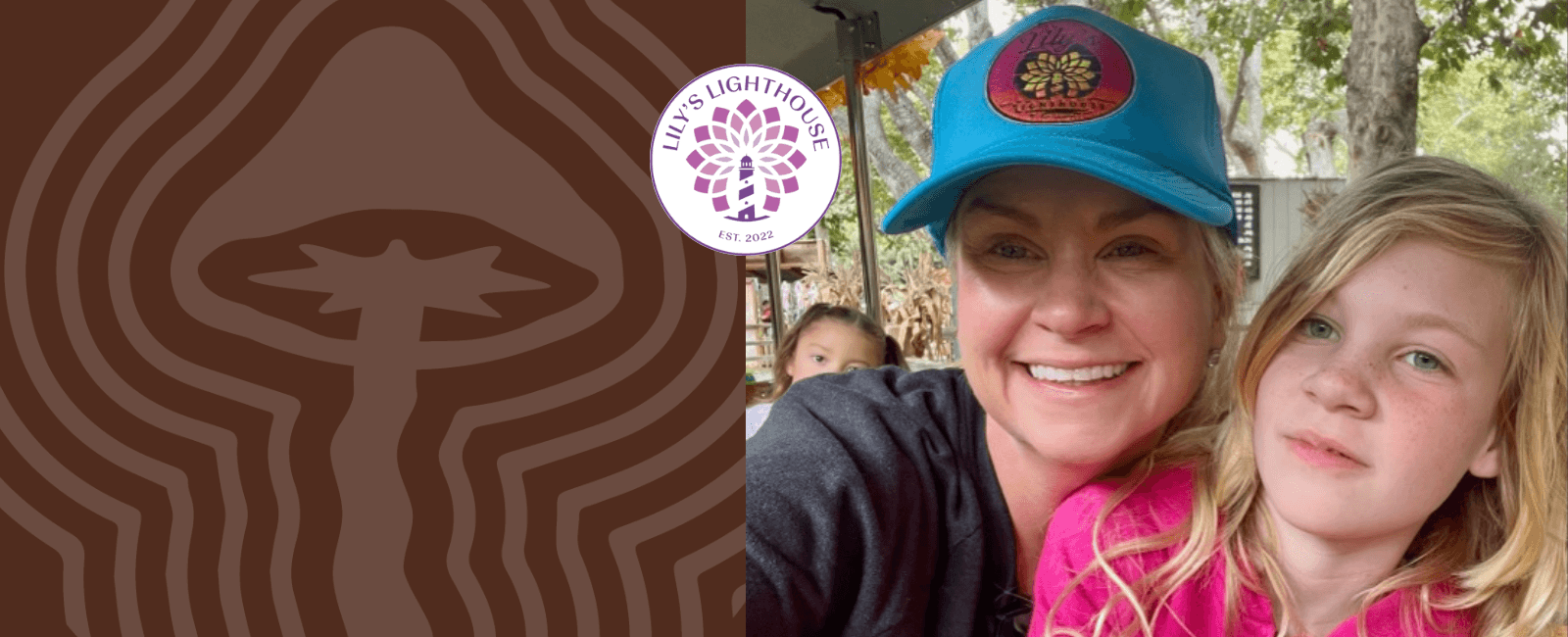

In this interview with Sarah-Kate Boylan of Lily’s Lighthouse, we discuss her family’s (often painful) journey of trial and error when her firstborn child Lily-Kate was diagnosed with intractable epilepsy during infancy.
After years of experimenting with medicines and surgery, this mother’s love, coupled with her background in research, plus a good friend’s timely nudge to try a sample packet of functional mushroom powder, ultimately led her to “unlock the key” to Lily’s wellness that had eluded them for so long.
Lily’s Lighthouse is a non-profit dedicated to bringing awareness, clinical research, and funding to alternative therapies including functional mushrooms, hippotherapy (horse therapy), and surf therapy to children living with epilepsy. The organization is at the forefront of a groundbreaking study on the effects of Reishi (Ganoderma lucidum) and Lion’s Mane (Hericium erinaceus) in treating epilepsy as an alternative therapy. Before you dive into the interview, 👉 learn more about the study here.
Vivian Kanchian: You were just telling me how beneficial horse therapy and surf therapy have been for Lily.
Sarah-Kate Boylan: They’re both such incredible services, but they’re usually outside a traditional sit-down learning environment. These kids are getting feedback from the horse, and different benefits from the surfing. And these therapists are able to partner with speech therapists, physical therapists, and occupational therapists.
We’ve seen really huge successes in Lily’s growth and development using these services. But they’re not covered by insurance. So, once I get the funding in place for our primary mission of mushroom research for epilepsy that will result in a mushroom therapeutic, the next step is for me to be able to support the community and bring these services to kids who don’t normally have the opportunity.
It really saddens me that there is so much out there that can facilitate the growth and development of these kids, but they just can’t access it. So for me, that’s really really important.
When we had Babette (Lily’s alert dog) come into our family, Lily was having so many seizures. I couldn’t even get the basic fundamentals of running a house done, like washing the dishes and doing laundry.
I would have to take Lily everywhere because I had to be around in case she had a seizure. And then, when Babette came along, it was really the first time I was able to leave Lily-Kate alone, and to do these tasks. There was a real sense of freedom to that.

VK: That sounds like such a godsend. So, is Lily your only child?
SKB: No, I have three children. I guess you could say I’m a bit of an overachiever. So my little two…Brody, he’s 5, and Emma just turned 7, so they are very close in age. And Lily will be 10 soon. Having siblings, for Lily, has been just such an amazing thing, you know. She’s got such a support network around her, and because of Lily’s condition, her siblings have this kindness and empathy about them that just can’t be taught. You know, they’re just incredible humans.
And that’s the upside of having siblings with a child who has special needs or a disability. It creates very, very kind humans. I’m grateful that I was able to have them, you know.
VK: And how long ago did you get the dogs?
SKB: About 5 years now.
VK: I recently watched a documentary that brought the incredible work of 4 Paws for Ability to my attention, and this is where you got Babette! The story follows a child with epilepsy named Corinne whose sister felt a little invisible because she had to fill this role of caretaker so much of the time. Is there a little bit of that going on with Brody and Emma too?
SKB: Yes, my middle child Emma-Kate is 7, but she’s going on 16. When I had Emma-Kate, Lily was probably in the worst places of her life, medically.
She was having so many seizures. At the time, we’d implanted a device in her chest that gave her a completely different type of seizure than any we had ever seen. So, at the time I went into labor with Brody, Lily was having drop seizures. And, you know, it was pretty rough.
When Emma came along, she really took on the caregiver role of her younger sibling, Brody. They’re less than 2 years apart. Her job has always been to take care of him. If we go anywhere, I’ve got hands on Lily, and she’s got hands on Brody.
So, she has taken on a very large mothering role with him. And it’s been a huge responsibility for her, but I think that’s just part of the family dynamic. You’ve got to try to find a balance, and we’re all part of a community. And our little community doesn’t look like everybody else’s.
We all have to take on part of that community share. Then, there is that part of you that, as a mom, wants to protect them and let them be a child, so we try to do that as much as possible.
Now Lily’s in a much better place, and our family life looks a lot different than it used to, which is incredible.
We have the siblings now, and we actually have another support dog from 4 Paws named Cali for them. Cali wasn’t placed with a family because she’s got a heart medical condition. So, they place these “fabulous flunkies” with an existing 4 Paws family for the siblings.

VK: That’s so great, because I know siblings can often be tempted to feed a support dog and bond with them, which they’re not supposed to do. So, now they have their own!
SKB: You know, Lily’s dog is so good at her job now that it doesn’t really matter. For us, it’s never really been an issue. I catch them doing things they’re not meant to, but it’s really not a big deal because she’s just so good at what she does that we don’t have to be that strict about it.
VK: So, I’d love to learn a little bit more about you and about this journey. Would you mind just telling me what it is about you that made you think maybe there could be something else, something outside the box, that might finally help Lily? And that perhaps there were some blind spots in the treatments that were being offered within the conventional medical system?
SKB: It was really a few things. I spent my career in law enforcement. That’s my background. I originally trained as an intelligence analyst, so research is my capability.
When this happened to Lily, she was 5 weeks old and I was a first-time mom. So, this was a whole new experience for me, and I didn’t know anybody with epilepsy, but I wanted to find out as much as I could about it – so I did.
I didn’t realize at the time what a difficult condition it is to control. I also didn’t know that in 1/3 of people diagnosed with epilepsy, none of the available treatment options work. When you look at the numbers, with one in 26 Americans having epilepsy, and one third of them unable to find a solution… those statistics start to get pretty high.
So, when this happened to us, I just thought it was a blip, I thought we would get through it, but it doesn’t work that way, you know. Lily had failed every available treatment option. And because of my background, I would spend every available moment that I had researching and trying to find the answers.
As an analyst, you think outside the box. Because you’re trying to solve a problem that nobody else can solve. So, I was very open to every type of research, even if it was not epilepsy-specific.
There was a renaissance of research coming out on psychedelics a few years ago, and that’s really what pivoted me to mushroom research. I had no thoughts of giving Lily psychedelics. I just wanted to find out as much as I could about how mushrooms were working on the brain. I came across a few intelligence gaps in my research.
From then, I was pretty confident that I would potentially be able to find some non-psychoactive mushrooms, functional mushrooms that could benefit Lily.
Now, keep in mind that at that point in our journey, we had been impaired by this condition for so many years and Lily was not doing well at all. We were using rescue medicine up to 3 times a week. We were running out of time, and I was scared I was going to lose her.
So, at that point, there was definitely some desperation. You feel like you’re up against the clock. When you have a child that has uncontrolled seizures, the outcome and prognosis isn’t good. These kids die.
So, I really did a deep dive into functional mushrooms. I came up with a couple of them that I really wanted to try with Lily. Then, I spent 3 months really researching the supplement industry, because all supplements are not created equal.
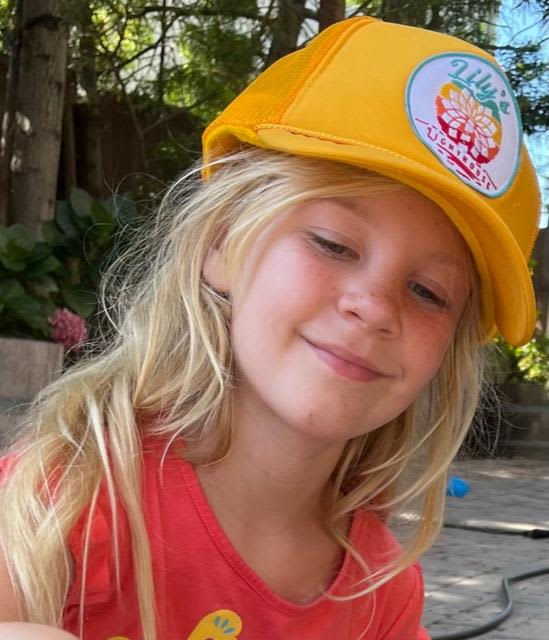
Last year, I spent a lot of time giving keynote presentations to the industry about what I expect of them when we’re talking about mushrooms as medicine. Now that I had found the mushrooms I wanted to try with Lily, I put a test group of us on it, and we all began to feel really incredible.
At the time, my hope was that the mushrooms might just help Lily with the fog she was experiencing being on 12-15 pharmaceuticals at one time. By this point, we had tried an implant device. She’d been assessed as a poor candidate for brain surgery. Nothing was working, and I was just trying to help her get a better quality of life.
But we didn’t have the foresight of just what would be unleashed when we first gave her the mushrooms. From the first day, she went 9 ½ weeks seizure free. You’re talking about a child who was using rescue medicine 3 times a week and was having up to 100 seizures a day for 7 years straight, you know. I mean, it was quite shocking.
So, we made it to Thanksgiving seizure-free, and then the tryptophan in the Thanksgiving turkey triggered her. Now that we have some control over the epilepsy, we are really figuring out her food triggers, which is a really big thing for epilepsy.
After that, Lily went 2 ½ months seizure free, and that’s when we filed as a nonprofit for Lily’s Lighthouse. We felt a real responsibility to get this information out to families like ours who were struggling with this condition. And our mission was to fund mushroom research that would result in a therapeutic for the treatment of epilepsy.
VK: Just incredible! And from what I understand, you launched your research studies this January 2024. Is that right?
SKB: Yes, we’ve partnered with two other nonprofits, called The Realm of Caring and Unlimited Sciences, in our battle against epilepsy.
We’ve gone through the IRB process, and we’re rolling out the study right now. We’re hoping to have the data collated by the end of March 2024, and then plan to be reviewing and publishing the outcomes by end of the year.
VK: So, what type of study are we talking about?
SKB: The study will encompass a series of case reports. It’s a retrospective study into people who have been using mushrooms for the treatment of epilepsy. So, we will be looking at their experience, how it’s affected their seizure counts and duration, and how it has impacted their quality of life based on the caregiver’s perspective.
We’re focusing specifically on 2 particular mushrooms (Reishi and Lion’s Mane). Lily’s actually on a blend of seven different types of functional mushrooms. And these are the 2 that we’re focusing on for this study.
👉 Learn more about the study here.
VK: Any sneak peeks into what you’re seeing so far?
SKB: We’re seeing huge cognitive gains, we’re getting reports of fewer seizures (if they’re still having seizures), and we’re seeing reports of shorter seizures.
We’ve had anecdotal reports of kids being able to do things for the first time, like ride a bike days after they started taking the mushrooms. Or that they couldn’t talk before and are beginning to say a few words. These are some of the really huge gains that we’ve been seeing.
We have had reports of kids who had been suffering from multiple seizures a week and are now going a year or more seizure free.
VK: Curious to know what the impetus is behind creating a therapeutic? Is it to standardize the medicine? Is it to prove scientifically that the mushrooms are safe and effective?
Because there are some very reputable supplement companies that make excellent and effective products already, that Lily is currently taking.
SKB: For me, it’s about validating efficacy of the use of mushrooms for the treatment of epilepsy. Also, being an advocate for children is very important to me. We’re talking about minors who can’t make decisions for themselves.
During our journey, and before we started Lily’s Lighthouse, I met so many people in the epilepsy community. I was meeting people through our hospital stays, or while networking.
I came to realize that there are 3 different types of parents: the parent that will only do what their doctors/medical professionals will say and only take advice from medical professionals; the parent that will only do holistic things and does not want to administer pharmaceuticals at all; and then there’s the parent like myself who is integrated, and I don’t really care what it takes. I’ll do anything if it’s going to improve Lily’s life and help her.
If I can prove that this works, and a doctor can then say it’s okay to those parents who will only do what the doctor says… then maybe these children have a chance. Maybe they don’t have to die. Maybe there’s another option out there for them that wouldn’t otherwise be available.
Our study partners, The Realm of Caring, were pivotal in pushing forward CBD research for the treatment of epilepsy, that resulted in a CBD therapeutic called Epidiolex. They’ve done it already. Now, we’re doing exactly what they did for the same condition – only with mushrooms.
And I’m very driven – I will get it done.
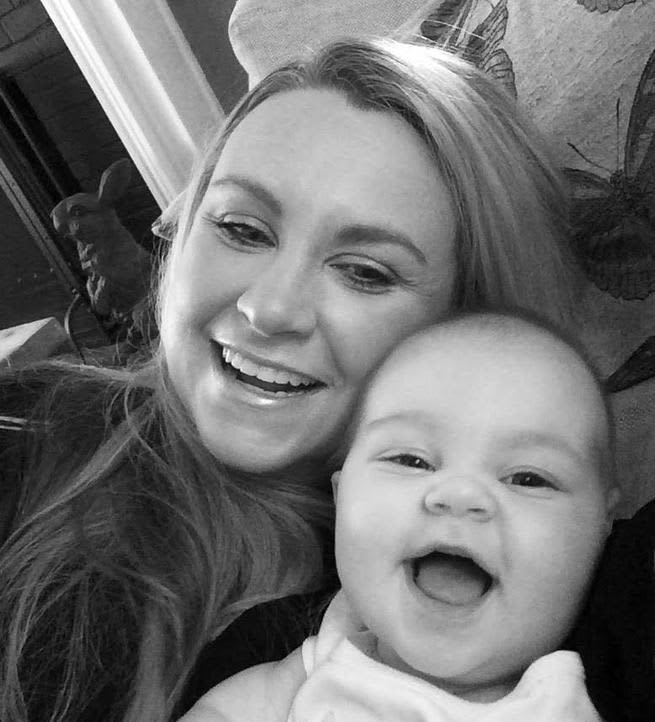
VK: Oh, I believe you.
I understand that Lily is still on one pharmaceutical (in addition to the mushrooms) now, but I still can’t help but wonder whether there is a certain part of you that was pissed off at the system for not being able to offer up a better solution for all those years?
SKB: Right, we are still giving her one pharmaceutical, but it’s not in therapeutic range. So, we don’t actually know if it’s doing anything. And we stopped weaning her from the medication because we were doing a lot of traveling as a family in the last year, which is such a trigger for Lily. We didn’t want to mess with it and add another variable in because everything was so good.
But no, I don’t think I ever felt pissed off. If I’ve ever been knocked down by something, I’ve kind of just used it to fuel me rather than eat me up, you know.
I actually feel very healed by this journey with Lily. The frustrations that I had about her previous treatment options, I feel a certain peace about it now, because I don’t think any of those treatments were meant to work for Lily. I feel that this was always the journey for her. I feel that we’re absolutely in the place we’re meant to be, and I feel extremely grateful that we are able to help others in that journey.
The way that you work a pharmaceutical for epilepsy is, you push it. You push it up to the point where it cannot be tolerated anymore, until these kids are out of their minds, to determine if they’re unsuccessful.
And some of them don’t make it. If you have a kid with uncontrolled seizures, the risk of them dying in their sleep is huge. I still sleep with Lily every night, because it’s always there, you know. She’s really well controlled on mushrooms now, but she still has seizures, you know.
The other really important piece for me in pushing for this mushroom research is that the kids are less impaired. Lily’s so close to being seizure-free, but there’s still so many intelligence gaps for me.
She’s gone from having up to a hundred seizures a day to one seizure every couple of months, and at times longer. She’s been going for weeks and months, completely seizure-free.
If I can figure out what bioactive compound(s) are working to do this, and what brain receptor(s) they may be working on, we can potentially produce an even better treatment option.
The research piece is really ongoing in my mind, as to how in depth I need to push it.
VK: I think one of the things that Lily’s story really brings to light is that often our medical system tells us that you just have to live with your condition, no matter how debilitating that might be. And sometimes, that may be true.
More often than not, though, we need to begin thinking differently about chronic conditions and consider that maybe there’s just a huge blind spot with the treatments that we have available because there is no profit to be made from researching them.
SKB: That is very true. And we did see that, for sure, with the pharmaceutical grade CBD equivalent. We saw Epidiolex come out, and families were having to pay $8,000 a month to access that medication for their kids.
On the other hand, because it was backed by research as a pharmaceutical grade therapeutic, some parents were able to open their minds to the concept – whether it was a CBD oil they bought from a reputable company or Epidiolex. It validated CBD for them.
I think that Realm Of Caring’s CBD research was very pivotal in getting people to look at medicine differently – as more of an integrated approach.
We’re seeing a lot more discussion now around things like chiropractic care and other natural therapies that were shunned before. And because mainstream medicine isn’t working for all of us and it’s not all-encompassing, people are realizing that there are other options – and that’s really great. I think that we need to be in a position where we’re more integrated, and the pharmaceutical companies and mainstream medicine are realizing that, too.
VK: Oh, from your lips to God’s ears.
So I want to talk a little bit about your art. I notice that you make these beautiful floral paintings… and I see there’s a painting of what looks like a peony behind you. Is that to raise funds for Lily’s lighthouse?
SKB: Yes, I’m working on that one now. It’s not completely finished, but it’s the twin of a painting I sold.
I actually started painting during Covid. I’d never painted before, and I always wanted to. I had traveled the world and visited all the famous art galleries, multiple times, and I just loved art. It was such a passion of mine, and I always thought to myself, “oh, I wish I could paint”. And one day, I just tried and that came out.
Now, I paint in the kitchen around the kids at night. I don’t get the opportunity to paint as much as I would like because I’m very consumed with Lily’s Lighthouse. But I do, and I sell my pieces to raise money for the foundation.
VK: Simply beautiful!
Can you share what role medicinal mushrooms now play in your family life?
SKB: Well, our whole family is taking mushrooms now. Everybody I know is. As my husband says, people that are not taking mushrooms are at a major disadvantage.
And we really feel that way, you know. When we tested Sacred 7 during the research phase of what supplement companies we were going to use for Lily, I really identified a couple of companies at the top, and Naturealm was one of them.
And the way that we ended up on it was totally random and an interesting story. I’ll tell you, because I think you’ll like it.
At the time, I had decided we would either be using Naturealm or Real Mushrooms. A friend of mine who’s a lifestyle coach and a fitness instructor to the stars was driving back to LA from San Diego, and he stopped by for a coffee.
I hadn’t seen him for nearly a year, and he brought with him these packets of powdered mushroom supplements he wanted me to try. He’d been taking them for 2 years and said he felt incredible. He had no idea I’d been researching mushrooms for Lily. It was just a totally divine coincidence. And what he handed me that day were samples of Naturealm’s Sacred 7.
So, that’s how we ended up on a blend, because when I looked at the 7 mushrooms in it, Reishi and Lion’s Mane were included in the list. And those were the 2 mushroom species that I had identified that I wanted to try with Lily: the Lion’s Mane for its neuro-regenerative properties, and the Reishi as a potential anti-convulsant. I figured if I could pair those, it could be a perfect marriage.
When Tim gave me the samples, it was just like being handed the golden ticket. I already had Naturealm’s website and a Journal of Medicine study from the 1900s up on my computer screen… and I thought, “Okay, that’s it. That’s the one”. With that, I knew I was doing the right thing.
VK: Wow! Sometimes, when the research stops, the intuition kicks in.
SKB: Definitely, especially when you have intelligence gaps. You just gotta trust your gut.
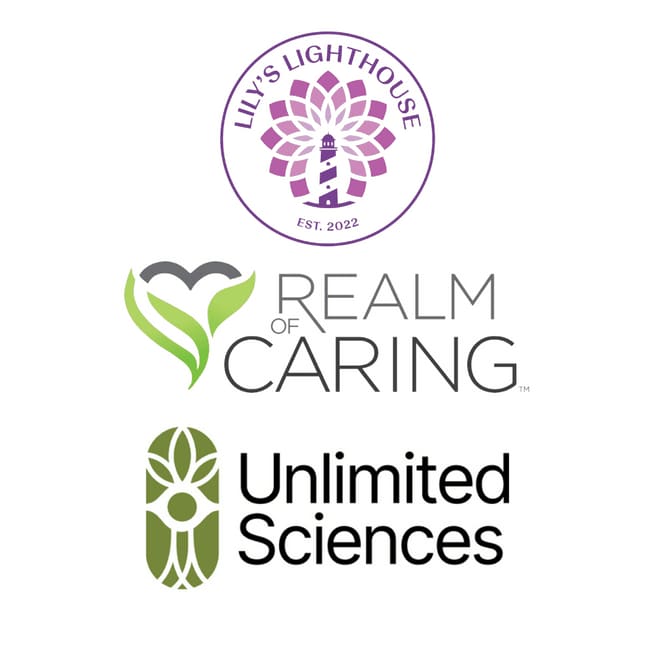
VK: So, can you walk us through what it took to get the ball rolling on this multi-phased retrospective study?
SKB: I’m ex-law enforcement, so I didn’t know anything about the mushroom world, really. Now, it’s all I do, you know. But I began by joining The Association of Foragers, I grew mushrooms all over the house, you know. I started getting out and talking to people and telling our story.
It was big for me to really get out to (the mushroom) industry and really talk as much as I could last year and share our story. And through sharing the story and the impact, you start to find the relationships.
It was a little bit divine how our relationship unfolded with Realm Of Caring (ROC). Del Jolly, the founder of a mushroom company called Umbo, was one of the original founders of ROC and Unlimited Sciences, and their mission is to fund mushroom research.
When the original CBD product came out by Charlotte’s Web, that was because of one of the other founders, Heather Jackson. Her son Zakia was very impaired at the time he started CBD. So, the relationship with Del, Heather and all of them… Sasha, who’s now CEO of ROC, was really solidified within the epilepsy realm, you know.
When they had heard about us using mushrooms for epilepsy, that felt very organic. You know, we really had the same mission – only their original mission was to fund CBD research for epilepsy.
When we got together, we felt really blessed, because if we could partner with anybody it would have been them. But how we kind of found each other… I didn’t seek it out. It just organically came together. We were gonna find each other, no matter what.
I feel very much that when you are on the right path, doing the right thing, you attract the right relationships. You just gotta back yourself. Go out there and do it and let it happen.
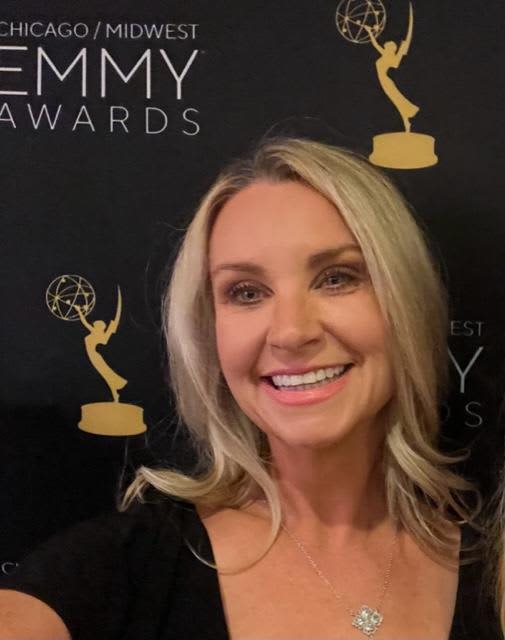
VK: That’s a great philosophy!
I’m curious to know how Lily’s doctors reacted to this miraculous transformation that she’s had? Have they been supportive? Were they shocked?
SKB: Her old neurologist, a retired professor who taught at Rady Children’s Hospital, has been working on a paper about Lily in his retirement. He was very supportive of me while I threw all kinds of outside-the-box ideas at him, and he always supported me in my thought processes.
When it came to the mushroom realm, it was shocking for him because he’d never heard anyone else that had tried mushrooms for epilepsy and was instantly changed by them like Lily.
I’ll give you a really big example. Outside of her seizure change, was Lily’s physical therapy goal. Eight weeks before starting mushrooms, the goal was set at “Lily will navigate her environment and only fall once a day.” At the time, she was falling up to 10 times a day (even with Babette’s help) and was covered in bruises. She couldn’t navigate the stairs on her own.
Then, 8 weeks after starting the mushrooms, she was assessed through the school district as physical development age for physical therapy and has not required any service ever since.
So, you’re talking about a girl who couldn’t even navigate her space without hurting herself and getting injured, to being fine just weeks later. Very quickly, we could see how mushrooms had impacted Lily’s life in multiple areas, not just with her seizures but also with her gut health. I mean, every area had seen such a significant improvement that it was undeniable.
In her first week on mushrooms, Lily’s physical therapists and occupational therapists were asking what we had done, what had changed? She was like a different kid. She’d hit 3 tasks in her first week at this session, that her therapist had been trying to get her to hit for the last year.
VK: Wow! What did that feel like, after so many years of disappointment? Was it hard to believe?
SKB: It felt like we put a key in a lock and turned it, and Lily was let out for the first time. That’s what it felt like to me. It felt like we were meeting her for the first time, because before it would just be like Groundhog Day with her.
She was in a constant cycle of learning and unlearning. She would learn to talk, or learn to do a skill, and then by the end of the day she would have had so many seizures that she would be in a postictal coma for 3 or 4 hours a day. And she would just lose it all. It was exhausting, honestly.
So, to suddenly be in this position [where it’s hardly happening anymore] was miraculous. We couldn’t believe it. And I became so driven to get this information out to people. I couldn’t just sit on this.
When you’re looking at children who have been on these heavy grade pharmaceuticals, and you look at the side effects that are listed, you see that the first side effect listed is actually seizures. Some other side effects are depression, suicidal thoughts, and the list goes on and on.
Then, to look at Lily on mushrooms and see that the side effects are big cognitive gains… it’s like, wow, that’s amazing – how incredible!
VK: Just incredible.
Can you tell us how you arrived at the half teaspoon dose, that Lily takes three times a day?
SKB: Sure, when I looked at mushrooms for epilepsy with her. I really just piloted off implementing a regime that you would with any other pharmaceuticals. The general rule is to start slow and with a small dose, and then over time you incrementally raise the dose as necessary. And I applied the same methodology with mushrooms.
I didn’t actually know precisely where or when to stop. I just stopped at the point when I wasn’t seeing any further cognitive gains. Now, I don’t know if I went up even higher than that, if it would knock out that one seizure Lily has every so often.
But I kind of just stopped there. Whether she even needs to be on the current dose she’s on, I don’t even know, because we saw such massive gains in her seizure control pretty early on. The 3 doses a day, I think, are important with Lily, just because she’s always had an incredibly fast metabolism.
And I’ve always known that with pharmaceuticals, particularly, or any other type of supplement, she’s always had to eat very regularly. Otherwise, it will trigger a seizure. So, that’s why I do it that way.
I dose 2 hours away from pharmaceuticals just to mitigate any potential interaction, and I don’t know if there are any. I personally haven’t heard of anyone having an adverse reaction using their pharmaceuticals alongside mushrooms yet. That’s not to say that there aren’t. Hopefully, in the research phase, we will be able to figure that out.
What I’m seeing with other families that are trying mushrooms for epilepsy varies. Some kids are on a very small dose and getting seizure freedom. I know one boy who’s on a quarter of a teaspoon taken in the AM and PM, and he’s been seizure free for a year and a half.
Before the mushrooms, he was having multiple grand mal seizures a week. Then, I know others who are on 3 times the amount that Lily’s taking.
So, I would very much like to find out the therapeutic range in our research so that there will be a guide like with any medicine.
VK: You mentioned you hope to have the outcomes published by end of 2024. What happens after that?
SKB: From that, we’ll be going into pre clinical trials. I’m currently fundraising $100,000 for the pre clinical study.
VK: The work that you are doing is absolutely fantastic. And I am so happy to hear that Lily’s doing so great. It makes my heart sing!
Thank you so much for sharing your inspiring story.


